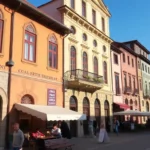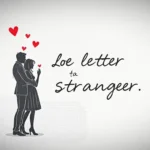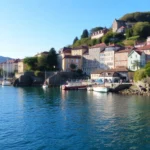Things to See and Do in Sarajevo

Are you looking for ideas on things to see and do in Sarajevo? This post reveals the captivating experiences waiting for you in this remarkable city of Bosnia.
On September 15, I had a blind date. I had been anticipating this moment for so long. I was nervous, excited, and felt emotions I hadn't experienced in a long time.
Sarajevo welcomed us with a blue sky and a scorching sun, contradicting my preconceived notion of it being a white, cold city! We boarded an old, dusty tram that seemed to have traveled through a time tunnel. Along the way, a group of children greeted us with laughter. Are these kids so different from those in 1991? This question lingered in my mind as I looked out at the houses of Sarajevo, once scarred by the bullets of snipers hiding in the hills surrounding the city. Rober glanced at the road, and I felt chills run down my spine. What was it like to fall in love back then? Your life had to be a tightrope walk—suspended between the threads of war and the life and death of your beloved. Lovers are doubly brave.
As the tram took a left turn, the Miljacka River appeared, a calm and dark artery dividing the city. Suddenly, the Latin Bridge came into view, the very site where Archduke Franz Ferdinand of Austria was assassinated in 1914, marking the beginning of World War I. We were nearing Baščaršija, the Turkish quarter, the historic heart of the city that, in my mind, smells of Turkish coffee, baklava, and hookah smoke.
As I savored my imaginary baklava, a magnificent red and yellow structure caught my eye, signaling it was time to disembark: Vijećnica, the old Sarajevo library, now a town hall. This building was set ablaze by Serbian bombs on the night of August 24-25, resulting in the destruction of over 2 million books, pages of history, and poetry. It was here that one of the most haunting yet delicate images of the Bosnian War was captured: Vedran Smailović, the Sarajevo cellist, playing amidst the library's ruins.
We spent three days in Sarajevo, traversing kilometers of its skin, gazing into its soul. We explored both its brightest history, the 1984 Winter Olympics, and its darkest chapter, the war. We visited the Tunnel of Hope, which allowed food and medicine to enter the city during its siege. We passed by the Markale Market, the site where a grenade killed over 60 people waiting in line for a piece of bread one fateful February day. Our footsteps led us to the ‘roses of Sarajevo’, red-tinted imprints left by bombs and grenades that claimed three or more lives.
Yet, we also discovered a city eager to live, filled with terraces and glasses of beer, exuding confident glances and firm steps. A war doesn’t make you stronger, but surviving one does: as if your new life holds more value, as if you have to live for yourself and for those who weren’t as lucky.
We encountered intriguing stories, such as that of the owner of the Inat Kuca tavern, who had his establishment on the same site as Vijećnica. He agreed to give up his land for the Austrians to build the library only under two conditions: a box of gold coins and that they dismantle and reassemble his tavern stone by stone across the river! He got what he wanted, and today, Inat Kuca stands in front of the town hall, almost winking at it.
Tip: There’s no better way to get to know Sarajevo than by taking a local-guided tour. This one is highly recommended (and it’s in Spanish!). It costs €17 and lasts 2 hours.
As hunger struck, we devoured Sarajevo: the first bite tasted of spinach and cheese burek, the second of grilled cevapi served with kajmak sauce, the third of walnut and honey baklava, and finally, the flavor of transparent, delicious Turkish tea lingered on our palates.
If I had to choose one moment from ‘our date,’ which inevitably turned into a love triangle, it would be at sunset when we came face to face with the Sarajevo skyline. This skyline is shaped by the minarets of mosques, the bell towers of churches, the concrete monsters of the communist era, and especially by the silhouettes of white tombstones that tickle the sky… Sarajevo has no parks; they were all used to provide dignified burials for the victims of a war that screamed for the world while it remained silent. Suddenly, all the minarets of the mosques came alive with the evening prayers. It was as if the city was speaking to us, embracing us, and I felt like shouting ‘Volim te Sarajevo’, I love you Sarajevo, but the city doesn’t need shouts; it needs ears. I sat back down, listened, and loved it in silence.
Sarajevo with an S for silence, for suffering, for blood, for dreams, for survival. But above all, Sarajevo with an S for feelings, mine towards it. On September 15, I had a blind date. By September 16, I was madly in love.
P.S. If you came here looking for things to see and do in Sarajevo, I have just one recommendation: love it.
Useful Information
Where to stay: We spent three nights at Pansion River.
How to get to Sarajevo from Mostar: The best (and cheapest) option is by train. We took the 07:06 train. I highly recommend it, as it passes through stunning landscapes. It costs about 10 KM (€5).
How to get to the city center from the station: Take tram line 1, which costs 1.60 KM (around €0.8).
Recommendation: We did a tour with Sarajevo Funky Tour, which we highly recommend. It was the Siege tour, during which a qualified guide explained everything that happened during the Bosnian War. The tour lasts about three hours and covers several critical points in Sarajevo during the conflict (Holiday Inn Hotel, Sniper Alley, Markale Market, Peace Tunnel), as well as the Olympic area (bobsled tracks, now covered in graffiti) and a viewpoint in the mountains overlooking all of Sarajevo (where you can understand how easy it was for snipers to target civilians). Our guide was Dado, whom I highly recommend. The tour costs €20, money well spent.





Deja una respuesta